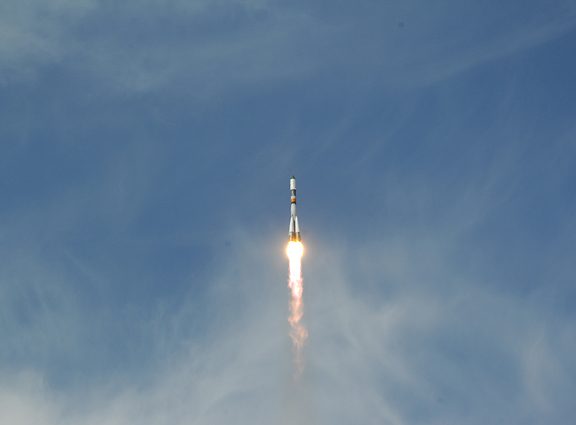Russian Space Cargo Droid Leaves Earth For the International Space Station

Russia has been sending Progress robot freighters with cargo to the International Space Station for more than a decade – and to its Mir and Salyut space stations for decades prior to that. They did it again today with Progress M-67 (also known as Progress 34P) routinely (yawn) as they have many times before. These photos (below) show part of the process of preparing these cargo droids for their trip.

Russia has been sending Progress robot freighters with cargo to the International Space Station for more than a decade – and to its Mir and Salyut space stations for decades prior to that. They did it again today with Progress M-67 (also known as Progress 34P) routinely (yawn) as they have many times before. These photos (below) show part of the process of preparing these cargo droids for their trip.
July 13, 2009. Baikonur launch site, branch office of S.P.Korolev RSC Energia. Progress M-67 cargo vehicle balancing and weighing was completed.
July 15, 2009. Baikonur launch site, branch office of S.P.Korolev RSC Energia. At Baikonur launch site the preparations continue for the launch of Progress M-67 cargo vehicle under the International Space Station program. Progress M-67 cargo vehicle fuelled with propellant components and compressed gases was delivered to the Spacecraft Assembly and Testing Facility for final processing operations.
July 17, 2009. Baikonur launch site, branch office of S.P.Korolev RSC Energia. At Baikonur launch site the preparations continue for the launch of Progress M-67 cargo vehicle under the International Space Station program. Progress M-67 transport cargo vehicle was docked with the transfer compartment in the Spacecraft Assembly and Testing Facility.
July 19, 2009. Baikonur launch site, branch office of S.P.Korolev RSC Energia. At Baikonur launch site the preparations continue for the launch of Progress M-67 cargo vehicle under the International Space Station program. Designers inspection of the Progress M-67 cargo vehicle was completed.
July 20, 2009. Baikonur launch site, branch office of S.P. Korolev RSC Energia.
At Baikonur launch site the preparations continue for the launch of Progress M-67 cargo vehicle under the International Space Station program. Orbital module of the Soyuz-U launch vehicle, containing Progress M-67 spacecraft was transported from the spacecraft processing facility for the general integration with LV.
July 21, 2009. Baikonur launch site, branch office of S.P.Korolev RSC Energia. At Baikonur launch site the preparations continue for the launch of Progress M-67 cargo vehicle under the International Space Station program. Orbital module of the Soyuz-U launch vehicle, containing Progress M-67 spacecraft was integrated with the Soyuz-U launch vehicle in the processing facility.
July 22, 2009. Baikonur launch site, branch office of S.P.Korolev RSC Energia. At Baikonur launch site the preparations continue for the launch of Progress M-67 cargo vehicle under the International Space Station program. Soyuz-U launch vehicle was rolled out from the integration building to the launch pad. Soyuz-U launch vehicle with Progress M-67 transport vehicle is installed on the launch pad. L-2 days activities have been started.
July 24, 2009. Baikonur launch site, branch office of S.P.Korolev RSC Energia
At 14:56:56 Moscow Time a transport cargo space vehicle Progress M-67 was launched from the Baikonur launch site.
The launch objective is to support further in-orbit operation of the International Space Station (ISS) in accordance with the commitments undertaken by the Russian side under the ISS Project.
The main mission of the space vehicle is to deliver to the Space Station different cargoes making up about 2.6 tons by weight and needed to continue the ISS flight in a manned mode and provide proper living and working conditions for the crew.
The space vehicle was put into a reference near-earth orbit with the following parameters: inclination of 51.64°, a minimum altitude of 192.6 km, a maximum altitude of 253.4 km, orbital period of 88.7 min.
The onboard systems of the space vehicle operate in design modes.
At the launch site, the space vehicle prelaunch processing and launch were performed under the direction of the State Commission (chaired by the Head of Roscosmos A.N.Perminov). The decisions taken in order to implement each prelaunch processing step and space vehicle launch itself were based upon the Conclusions of the Technical Management headed by the President of S.P. Korolev RSC Energia, Designer General V.A.Lopota.
According to the telemetry data and reports from the crew of ISS Expedition 20, the space station systems operate in design modes. The station is ready to be docked with the space vehicle.
The space vehicle docking is scheduled for July 29, 2009, at 15:16 Moscow Time.
For reference:
- S.P.Korolev RSC Energia is a Russian company of strategic importance, the prime organization in the Russian rocket and space industry that carries out manned space flights under the Programs, responsible for the development of the ISS Russian Segment, its integration into the Space Station and its operation, including development and operation of the main Russian Modules (Zvezda, Pirs, etc.), manufacturing, launch and operation of the Soyuz TMA and Progress M space vehicle.
- Sent from the ground to the orbit were supplies of water, food, gases, propellants, consumables, scientific instrumentation and equipment.
- Currently working in orbit under the ISS Program are the following 13 specialist: from Prime Crew 20 (ISS-20) – Russian cosmonauts G. Padalka (ISS Commander) and R. Romanenko: American astronaut M. Barratt, European astronaut F. De Winne, Canadian astronaut R. Thirsk and American Astronaut T. Copra who replaced Japanese astronaut K. Wakata by crew rotation. From July 17, 2009 the US Space Orbiter “Endeavour” having the crew of 7 people aimed to perform works on the USOS, had been docked to the ISS.
- Cargo space vehicle Progress M-67 is the 34th Russian cargo space vehicle launched to the ISS under this Project.
You can also follow Progress activities here


















































































